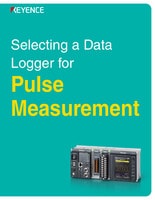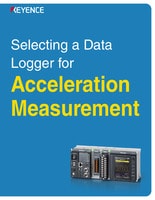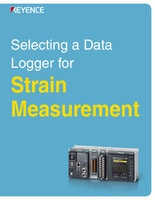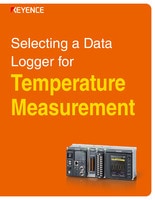DAQ / Data Loggers

Introducing a lineup with 8 different measurement units for measuring temperature, voltage, current, strain, acceleration, rotation, pressure, CAN, and more. This series can be used for a wide range of measurements, from simple measurement to multi-aspect, multi-channel measurement. The compact size makes it possible to carry the device directly to the measurement site, eliminating the need for storage space. The software is also easy to set up and use right away, even for first-time users. Meanwhile, collected data can be exported to Excel with just one click.
Lineup
The NR-X Series covers all the functions required of data loggers, including easy operation and compatibility with a variety of measurement applications. As the smallest and lightest data logger in its class, this palm-sized device can be used with 8 types of measurement units and can perform multi-channel measurement using up to 576 channels. The reduced-wiring system significantly reduces the effort required for wiring—the most time-consuming aspect of measurement preparation with conventional models. This ensures usability without having to worry about excessive wiring work, incorrect wiring, and restoration in the event of disconnected wiring. A help function with support for setup and easy-to-understand icons are included to make operation easy even for first-time users. Moreover, AC, DC, or battery power supply units are also available, with the high-capacity lithium-ion battery capable of up to 800 minutes of data collection. The wireless LAN unit also makes measurement possible from anywhere.
Features
Wide Variety of Measurements from a Single Device, Including Temperature, Voltage, Current, Strain, Acceleration, Pulse, and CAN Signal
Measurements are used to check, analyze, and report data. This makes faster measurements much more helpful. To increase the speed of measurements, however, measurement units must be comfortable to use. The NR-X Series software makes it easy to configure settings even without a manual or prior knowledge about operation.
Wide variety of measurements from a single device

For use in a wide variety of applications—from simple measurements to complex, multi-channel measurements.
Easily transportable

Compact and easy to carry.
Simplified wiring for simplified wiring work

Wiring can be routed from near the measurement point, making wiring work fast and easy.
Varied lineup of units usable in harsh environments both indoors and outdoors

Designed to withstand exposure to water, sand, mud, and high temperatures.
- Vibration/shock resistance : 10G/100G
- Cold/heat resistance : -40 to +85ºC (-40ºF to +185ºF)
- Water/dust resistance : IP65/IP67
- Outdoors/weather resistance : Enclosure Type 4X
The NR-500 Series is a multi-input data logger that can be connected directly to a PC. At just 20.5 mm (0.81 inch) wide and weighing just 110 g (3.88 oz), this ultra-compact and lightweight device is easy to use. Both the smallest and lightest in its class, the NR-500 Series is highly portable and can be installed even with limited space. It can also be easily combined with other measurement units as needed for high-speed, high-accuracy measurement across the desired number of channels. Unlike conventional data loggers, the NR-500 Series was designed with PC compatibility and simplified settings and operations in mind. With simple and speedy three-step operation—connecting to a PC, configuring the collection unit, and analyzing the data—work efficiency before, during, and after data collection can be significantly improved.
DAQs refer to various devices that are generally used to save data. Most conventional DAQs have been peripheral equipment capable of saving data that can then be read by computers. However, settings, operation, and data analysis can be complicated.
The latest standalone DAQs, however, enable analysis of saved data directly from the main unit. Moreover, both standalone and PC-connection types can be combined with a variety of measurement units, wireless LAN units, battery units, and other devices as needed to improve expandability, measurement accuracy, or responsiveness. Configuring the settings and operating the devices is also easy. The devices are highly compatible with PCs and other software packages. The included functions make post-measurement analysis and reporting of data quick and intuitive.
Benefits of DAQs
In addition to being lightweight and compact, KEYENCE DAQs are simple to set up and use for easy measurement anywhere. Compatibility with battery units and wireless LAN units also makes it possible to perform measurement in even more locations. The modular design without a backplane or chassis enables quick setup changes.
Conventional DAQs tend to be large, difficult to carry around, and difficult to install. KEYENCE’s NR Series of DAQs, however, are compact, lightweight, and high-performance for high-speed, high-resolution processing of multi-channel and multi-input measurements. The devices can also be used with a high-capacity lithium-ion battery unit in addition to AC power, allowing for measurement virtually anywhere. The optional wireless LAN unit also enables remote operation and setup for using the system from anywhere as well.
Utilizing its compatibility with a wide variety of measurement signals, KEYENCE worked hard to make its DAQs easy to use. In addition to simplified setup and operation, the devices are highly compatible with PCs and make working with collected data easier than ever.
Eight types of high-accuracy measurement units are available to meet a wide variety of evaluation and analysis requirements. Measurement is possible for various types of data, including voltage, temperature, strain, acceleration, pulses, and CAN—all completely synchronized.
With conventional systems, different measuring instruments were used depending on the number of the input signal or the signal type. Analyzing data acquired individually from multiple units was extremely difficult and required significant time and effort as well as skill.
KEYENCE’s NR Series DAQs use a unique measurement bus without a backplane or chassis to sample all measurement units in complete synchronization. This makes collection reliable even when dealing with different types of data, such as temperature and strain. Complete synchronization of the data also significantly improves post-measurement analysis and operations.
With conventional DAQs, connecting to PCs and performing analysis could be complicated. KEYENCE DAQs, however, are highly compatible with PCs and software, ensuring intuitive operation from the configuration of settings to analysis of acquired data.
The main purpose of most general-purpose DAQs is to save data. This means there is little consideration for PC and software compatibility or data analysis operations. Not only are conventional DAQs difficult to connect to a PC and to set up and operate the system, but analyzing the collected data also takes significant time and effort.
Due to their high compatibility with PCs and software, KEYENCE DAQs help simplify operations and improve efficiency in new and unique ways. Waveform measurements and data can be converted simultaneously. Data can be output directly to Excel. CSV files can be automatically compressed for high-speed data transmission. Also, data analysis can be performed on the main unit as well as with dedicated analysis software, greatly improving analysis efficiency through intuitive operations.
NR Series Data Acquisition Case Studies
Temperature measurement example: Room temperature distribution with air conditioners
For performance evaluation during air conditioner development, it is necessary to check the room temperature distribution. KEYENCE’s NR Series of DAQs can obtain detailed temperature distribution data thanks to multi-channel collection of data from up to 576 channels. A remote unit is also available that significantly reduces the number of thermocouple wires needed, minimizing the time and effort required for setup even with multi-channel measurement.
Other examples are grouped into R&D and production site applications. These are further classified according to scenarios commonly seen in particular industries, such as the electronic device, electrical equipment, metal/steel, and plastic industries. Click the following link for more information.
Strain measurement example: Clutch durability testing and strain data analysis
During performance testing of automotive clutches, the pressure, strain, and temperature applied to clutch plates in operation are measured and the results are compared against the material strength to calculate the durability performance. In general, the strain and other properties are measured offline after on-vehicle testing for analysis. KEYENCE’s NR Series of DAQs allow for quick measurement of not only strain but also temperature and other data. Using a laser displacement sensor or similar unit also enables high-accuracy, non-contact measurement of changes in target shapes.
Other examples are grouped into R&D and production site applications. These can be further classified according to scenarios commonly seen in particular industries, such as the electronic device, electrical equipment, metal/steel, and plastic industries. Click the following link for more information.
Acceleration/vibration measurement example: Transportation testing for precision devices
During transportation by truck, ship, airplane, train, etc., products can be affected by vibration. This means precision devices must be tested through product evaluation for tolerance against vibration that occur during transportation. Products are evaluated by applying simulated transportation vibration by controlling the amplitude, frequency, and acceleration with a vibration generator. Due to the possibility of lengthy or extended transportation, it is necessary to continuously apply vibration for one or more days to identify at which vibration level malfunctions occur and to analyze their causes. With support for large-capacity SD cards, KEYENCE’s NR Series DAQs are ideal for this kind of long-duration testing.
Browse examples of acceleration and vibration measurement in various other industries as well, including the electronic device, electrical equipment, automotive, and metal/steel industries. Click the following link for more information.
Analog (current/voltage) measurement example: Data collection during on-vehicle testing
On-vehicle testing for automobiles often involves measuring analog signals output from temperature and pressure sensors. NR Series DAQs can measure and record multiple analog signals from different sensors. Measurement units can also be added for performing various types of measurements simultaneously with a single device, including temperature (such as intake and exhaust temperature), strain (such as the deformation of the body during operation), and CAN data output from the ECU. Using a battery unit and wireless LAN unit also enables remote control without having to run wires over long distances or needing an AC power supply in the engine room.
The examples included here are grouped into R&D and production site applications and highlight typical analog (current/voltage) measurements in various industries, such as the automotive, metal/plastic, electronic device, and food industries. Click the following link for more information.
Pulse frequency measurement example: Flow rate measurement for cooling water
Production sites use various liquids such as water and oil for cooling, polishing, cutting, etc. If the flow rate needs to be measured, a flow meter is generally installed on the target piping to measure the rate based on pulse signals. Because NR Series DAQs support pulse measurement as well, instantaneous and accumulated flow rates can be measured and collected based on pulse signals from a flow meter. This helps quickly identify problems on production sites.
Other examples are grouped into R&D and production site applications, which are further classified according to scenarios commonly seen in particular industries, such as the electronic device, electrical equipment, metal/steel, and plastic industries. Click the following link for more information.
CAN data measurement example: ECU evaluation testing
The NR Series Data Acquisition System can easily collect various types of signals from electronic control units (ECUs) by using a Control Area Network (CAN) data collection unit. The DAQs can also collect CAN data from multi-signal, multi-system buses completely in sync with analog data. Because of the simple design and no need for programming, the NR Series will significantly improve the efficiency of evaluation testing—which is conventionally very time-consuming.
The examples introduced here also include CAN measurement using a CAN data collection unit. Click the following link for more information.
Frequently Asked Questions About DAQs
The thermocouple or RTD type will depend on the temperature being measured, the required accuracy and other features. Because DAQs typically only support measurement with a limited number of thermocouple and RTD types, users often need to verify that the thermocouple or resistance thermometer being used is compatible with the DAQ before measurement.
KEYENCE’s NR Series DAQs allow users to perform measurement without having to worry about frequently checking the specifications. Nine different types of thermocouples and three types of resistance thermometers are supported.
Analyzing data collected by a conventional DAQ usually involves extracting the data from the main unit memory or recording media. With a KEYENCE NR Series DAQ, collected data is automatically saved to the PC and can also be automatically transferred to a server using the FTP client function.
The SNTP client function also synchronizes the time on the main unit with an SNTP server time for accurate data time management with no time adjustment needed.
As quality management standards become stricter, the need for measuring numerous channels is increasing.
Many systems use multiple DAQs to collect data from multiple channels, with the data being synchronized later in Excel.
KEYENCE’s NR Series of DAQs, however, can collect data from up to 576 channels with completely synchronized sampling.
With support for multiple inputs, the KEYENCE NR Series DAQ can collect various data from just a single device. This helps shorten data collection processing times and ensures the synchronization of data.
In this way, KEYENCE DAQs can solve various problems in situations where synchronized measurement is necessary, such as when collecting multiple types of data (such as temperature, voltage, and acceleration) or when collecting data from multiple channels at a high sampling rate.

From useful basic knowledge to techniques for improving efficiency, this website offers support for accurate measurement and analysis.

Browse detailed explanations on selecting a DAQ for pulse count or frequency measurements such as rotation speed, complete with measurement application examples, measurement tips, and other key points. This guide is recommended both for those just starting pulse measurement and those looking for ways to improve efficiency.

There are a wide variety of DAQs (recording instruments) capable of measuring acceleration. This guide provides an in-depth look at selecting the right device, from basic information such as acceleration sensor selection to information on the number of channels, sampling rate, and synchronized measurement of different data types.

Learn about the various DAQs (recording instruments) that can measure strain and how to choose the best one. Discover the various specifications and applications of DAQs to help make the right choice, from selecting a measurement unit for the strain gauge being used to deciding the number of channels, sampling rate, and whether simultaneous measurement of other input signals besides strain is necessary.

Browse tips on how to select the best DAQ for specific conditions and applications for current measurement with a focus on the measurable current types, number of channels, sampling rate, and simultaneous measurement of other input signals.

Learn about how to choose the best DAQ for voltage measurement based on several key points, including the maximum voltage being measured, the number of channels, accuracy, sampling rate, and simultaneous measurement with input signals other than voltage.

Learn how to check DAQ specifications to choose the ideal DAQ for temperature measurement according to the expected maximum number of input channels, the maximum sampling rate, the longest recording period, and other factors.